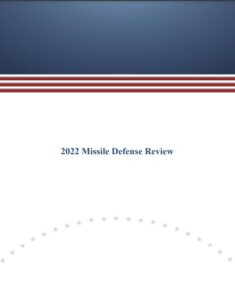The Biden administration’s new Missile Defense Review (MDR) maintains a push for 20 new Next Generation Interceptors while it continues to note this kind of system is only geared toward a threat like North Korea.
“As North Korean ballistic missile threats to the U.S. homeland continue to evolve, the United States is committed to improving the capability and reliability of the GMD system. This includes development of the Next Generation Interceptor (NGI) to augment and potentially replace the existing Ground-Based Interceptors (GBI),” the MDR said. The document was released on Thursday, nested within the unclassified version of the 2022 National Defense Strategy (NDS).

A fact sheet released with the NDS confirmed “the United States is committed to improving the reliability of the Ground-Based Midcourse Defense system and augmenting this active missile defense capability through the development and production of 20 Next Generation Interceptors as well as expansion of space and ground-based sensors.”
Earlier this month, the White House said it opposes a provision in the Senate’s FY ‘23 defense authorization bill that would require a funding plan to acquire at least 64 NGIs (Defense Daily, Oct. 24).
“By more than tripling the planned inventory of Next Generation Interceptors, section 1544 would be extremely costly and inconsistent with both the 2022 NDS and 2022 Missile Defense Review. The Department is exploring more cost-effective approaches to address the nuclear threat from North Korea,” the administration said.
MDA previously said it plans to procure upward of 20 NGIs that will have both a new booster and kill vehicle, to replace the canceled Redesigned Kill Vehicle. The agency expects the first NGIs to be fielded around 2027 to 2028. MDA previously built 20 silos for new interceptors at its GMD site at Fort Greely, Alaska.
The agency said the cost of procuring 20 NGIs would be over $11 billion.
In 2021, MDA selected teams led by Northrop Grumman [NOC] and Lockheed Martin [LMT] to start initial technology development and risk reduction work for the NGI, with competition set to proceed at least through the critical design review phase (Defense Daily, March 23).
In March, commander of U.S. Northern Command, Air Force Gen. Glen VanHerck, told the Senate Armed Services Committee that any plan to increase the number of Ground-based Midcourse Defense (GMD) interceptors past the current 44 older Ground Based Interceptors (GBIs) is a policy decision and he will look for guidance in the MDR.
“As far as the total number of 44 interceptors, that’s a policy decision. I look forward to seeing the Missile Defense Review and the policy that it provides in guidance to me to get after the capacity and challenges” related to increasing North Korean missile capabilities, VanHerck said (Defense Daily, March 24).
Last May, MDA director Vice Adm. Jon Hill told the Senate Armed Services Committee the Pentagon expects to decide precisely how many NGIs it wants to buy around 2024, after the preliminary reviews are complete (Defense Daily, May 23).

The 20-plus NGIs could be used to either replace some of the current 44 GBIs or add to them.
The MDR also repeated the insistence from both the Trump and Obama administration’s documents that “though the United States maintains the right to defend itself against attacks from any source, GMD is neither intended for, nor capable of, defeating the large and sophisticated ICBM, air-, or sea-launched ballistic missile threats from Russia and the [the People’s Republic of China]. The United States relies on strategic deterrence to address those threats.”
Last year, a group of Democratic lawmakers pushed the Biden administration to prioritize greater transparency and avoiding an arms race in then-discussions with China by making clear in the MDR that “no current or planned U.S. missile defense system will seek to alter the deterrence value of mutual vulnerability from strategic nuclear weapons” (Defense Daily, Nov. 5, 2021).
The latest version of the document also noted the GMD system of interceptors and sensors for “U.S. homeland defense capabilities provide the means to address ballistic missile threats from states like North Korea and Iran,” rather than Russia and China.
The document also admitted to the connection between strategic nuclear weapon defenses and offensive weapons, opting for transparency to reduce the chance that systems aimed at protecting against a limited North Korean nuclear threat inflames tensions with Russia or China.
“As part of an integrated approach to deterrence, the United States recognizes the interrelationship between strategic offensive arms and strategic defensive systems. Strengthening mutual transparency and predictability with regard to these systems could help reduce the risk of conflict.